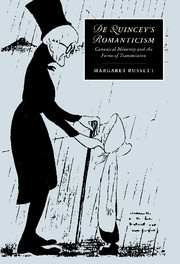Book contents
- Frontmatter
- Contents
- Acknowledgments
- List of abbreviations
- Introduction
- 1 Conversions: Wordsworth's gothic interpreter
- 2 Transmissions: composing The Convention of Cintra
- 3 Impersonations: the magazinist as minor author
- 4 Reproductions: opium, prostitution, and poetry
- 5 Appropriations: the counter-lives of the poet
- Epilogue: minor Romanticism
- Notes
- Index
- CAMBRIDGE STUDIES IN ROMANTICISM
4 - Reproductions: opium, prostitution, and poetry
Published online by Cambridge University Press: 26 October 2011
- Frontmatter
- Contents
- Acknowledgments
- List of abbreviations
- Introduction
- 1 Conversions: Wordsworth's gothic interpreter
- 2 Transmissions: composing The Convention of Cintra
- 3 Impersonations: the magazinist as minor author
- 4 Reproductions: opium, prostitution, and poetry
- 5 Appropriations: the counter-lives of the poet
- Epilogue: minor Romanticism
- Notes
- Index
- CAMBRIDGE STUDIES IN ROMANTICISM
Summary
THE COLOR OF PURPOSE AND THE FORM OF CONTINGENCY
In the Noctes, the Shepherd blunders by mistaking laudanum for the raw material of published Confessions, as though it were only necessary to lubricate the automaton of “On Magazine Writers” with “five hunner draps” to produce a saleable commodity. This is at least a plausible error, given De Quincey's earlier prediction that “this same opium” might enable him “to send [Blackwood] an article not unserviceable to [his] magazine.” In his less sublime moments, De Quincey often characterized opium as fuel or as the figure for alienated labor; “without opium I can't get on with my work,” he claimed, while apologizing for the “stains of laudanum” that obscured his manuscripts and deploring the drug's influence on his writing. Clearly, though, opium is not grist for the writer in the sense that paper, a dictionary of quotations, or even a topic might be; rather, opium frees the Kantian “faculty of presenting aesthetical ideas,” those “representation[s] of the imagination” which occasion “much thought, without however any definite thought, i.e. any concept, being … adequate to” them (K 157). The Confessions aestheticize a substance that itself promotes aesthetic contemplation: for example, “that particular mode of [the mind's] activity by which we are able to construct out of the raw material of organic sound an elaborate intellectual pleasure,” music (C 45).
- Type
- Chapter
- Information
- De Quincey's RomanticismCanonical Minority and the Forms of Transmission, pp. 135 - 177Publisher: Cambridge University PressPrint publication year: 1997

